begin quote from:
https://www.greattibettour.com/tibetan-culture/tibetan-clothing.html
Tibetan Clothing and Diverse Tibetan Dress Culture
- by Catherine
- Last Updated: 2021-08-18
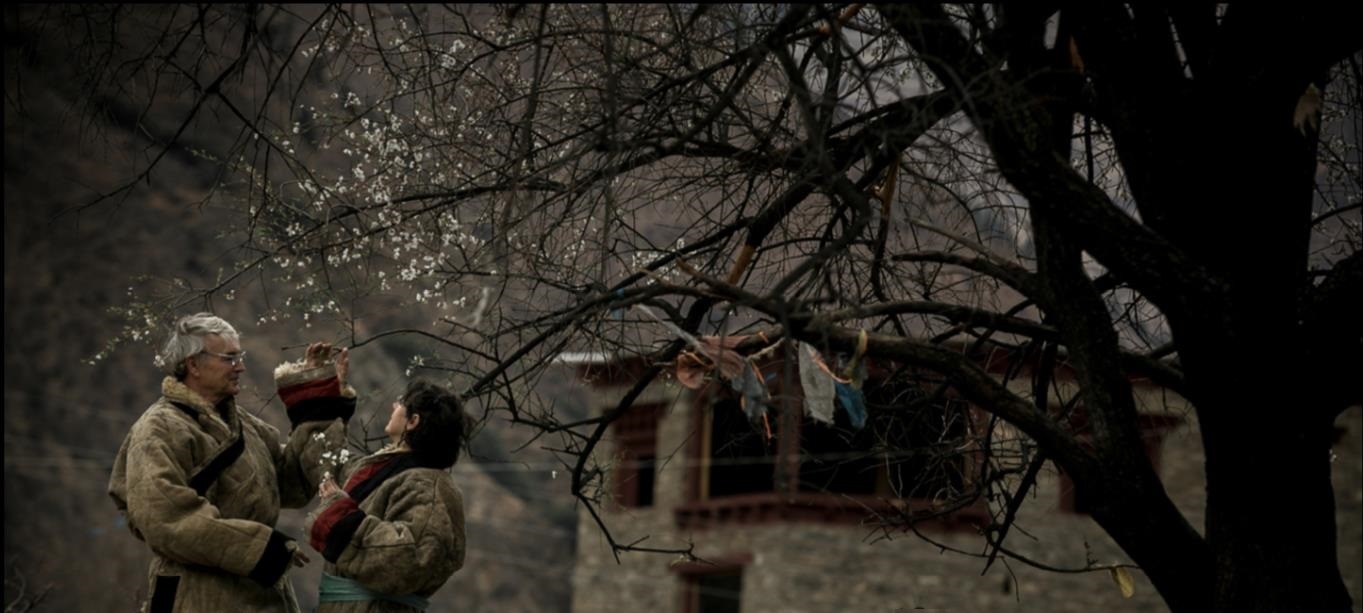
Tibetans are one of the oldest ethnic groups in China and South Asia. As the indigenous people of the Qinghai-Tibet Plateau, they've not only left previous cultural heritage including literature, music, dance, painting, sculpture, architectural art, etc. but also passed down the splendid Tibetan folk culture from generation to generation. Tibetans are an integration of the indigenous people of the Tibetan Plateau and a part of the ancient Qiang ethnic group. Staying on the roof of the world with high terrain, cold climate, and harsh natural conditions, Tibetan people live by livestock husbandry and agriculture. All these ecological environment and lifestyle determine their clothing form. The basic clothing features of the Tibetan ancestors are heavy and warm, fat waist, and long sleeve robes. According to historical data, as early as the 11th century BC, the basic characteristics of Tibetan clothing had come into being. Traditional Tibetan clothing is rich in connotation and diversity, with certain structural features, differences in levels and regions, and some specific rules.
Tibetan Men's Clothing
There are three types of Tibetan men's clothing: Le Gui (labor clothes), Zha Gui (formal dress), and Zha Gui (warrior clothes).
1. Le Gui

As the climate changes throughout the year, so does the labor clothing.
In spring and summer, Tibetan people generally wear a short shirt of cotton or white silk inlay brocade inside, with a large left and a small right front part, and wear a robe sewn by cotton and wool with round collar and wide sleeves (called Chu Ba in Tibetan). Then use a colorful belt (about 2 meters long, about 20cm wide seven-color striped wool long belt) to tie Chu Ba in the waist. The two sleeves are crossed and tied at the back of the waist, forming a bag at the waist for carrying things. The trousers are wide around the waist, crotch, and bottom. And the boots are short and the hat is in felt.
In autumn and winter, the labor clothes are all made of leather or artificial fleece. Chu Ba is also made of wool or sheepskin. Wear a leather cap with ear protectors, and high boots or self-made leather shoes.
2. Zhui Gui
Zhui Form is a kind of Tibetan festival dress and ceremonial clothing. The materials are expensive and the workmanship is exquisite. The formal dress is normally divided into two parts: undergarment and outer robe.
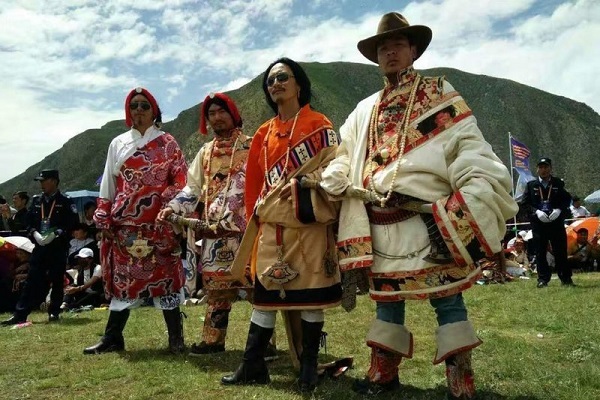
The undergarment is long sleeves, an asymmetrical front, and a high collar. The front and collar are inlaid with a gold or silver edge. Most people choose silk. The colors are generally white, purple, and light yellow. Some people choose patterned satin fabrics in various colors instead. The outer robe is made of brocade printed with the round Chinese "寿" word pattern, Lotus, and other floral patterns. The style is the same as the undergarment, but sleeveless.
Use Chu Ba's collar, cuffs, hem or braid with otter skin, leopard skin, and tiger skin for decoration. The width of the border is usually thirteen inches, the narrowest is five inches, and some have to use white fur on the border (Yong Zhongrenmu in Tibetan, symbolizes sturdiness and eternity).
The last step is to interlock the traditional floral brocade with the edge. In this way, Chu Ba's entire hem is almost covered with trim. The trousers are all made of white fluorescent silk. Footwear is Tibetan high boots with leather uppers. Men’s jewelry mainly includes Gawu (a small shrine, usually made into a small box for wearing on the neck), obliquely inserted waist knife, Chuba back hem with beautiful wave-shaped tail folds, hanging a silver knife with dragon-inlaid, Tibetan boots, etc. If you imagine such a picture, a handsome Khamba man comes alive, as well as his sturdy temperament.
3. Zha Gui
Wear a fox fur hat on the head and a long sword on the waist, dress in a woolen Chu Ba and hang an amulet on the neck, which shows the masculine beauty of the warrior’s heroic vigor.
Tibetan Women's Clothing
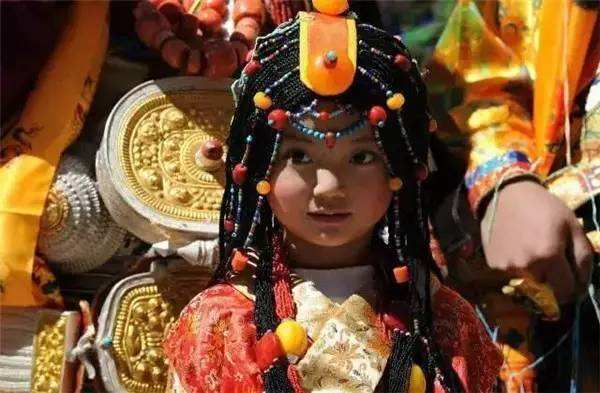
Tibetan clothing is mainly reflected in women's dress during festivals, major events in life, and ceremonies.
It is well known that Tibetan festival dresses are richer and grander than usual. Tibetan women in splendid attire have a deluxe headdress made of coral or turquoise, called "Bazhu" and gold or silver earrings inlaid a turquoise. They wear a silver bracelet on their left hand and a white conch bracelet on the right. The white conch has been worn since childhood, and it is said that it can lead people to the other side of happiness after death. They wear beeswax beads necklaces on their necks, hanging woman's amulet boxes with Buddhas or various sacred objects inside.
There's a great difference in women's clothing before and after adult rites and marriage, which is also a major feature of Tibetan clothing.
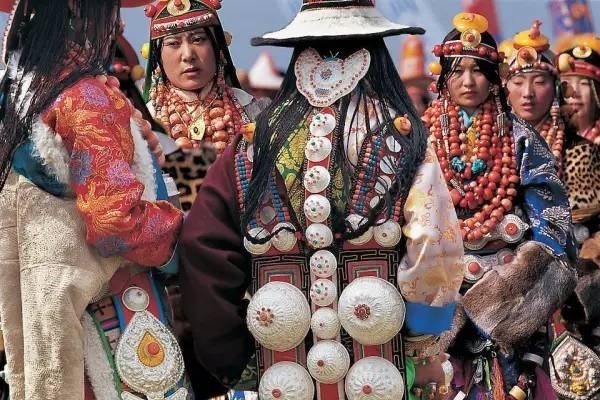
When the Tibetan girls in the Qinghai agriculture area reach the age of fifteen or seventeen, they need to change their childhood braids set to adult braids set. This is their Adult Ceremony, and the date should be a chosen auspicious day. First of all, ask monks to hold religious ceremonies, then the adult women help the girls dress up, worship Buddhas, ancestors, and parents. At this time, the female families sing worshiping songs for ancestors. At the age of fifteen, Haixi Tibetan girls must wear the "Marlton" (hair set), which is made of cloth or satin and decorated with many silver shields and corals. Guoluo Tibetan newly-married women are required to wear long-sleeved gowns with a rainbow-like stitch around the cuff of sleeves, and ornate vests. Similarly, Tianzhu Tibetan unmarried women's hair hoods are much shorter than married women's hair hoods, while Tibetan women in Aba Prefecture only began to braid after 16 years old. Unmarried girls in Zhuoni, Gansu, braid three plaits, however, married women here braid in the middle of the head and plait their hair from the waist down, not braid on both sides.
In addition, Tibetan women in rural areas like wearing bright rainbow aprons in front of their robes and combing their hair into double-braid. While Women in North pastoral areas prefer to comb their hair into countless small braids and put them behind.
Costume Culture in Different Areas of Tibet
In Tibetan areas, it can be said that the customs and style are different from where 100 km away. Tibetan costumes are extremely colorful and there are many differences between prefectures, counties, and townships.
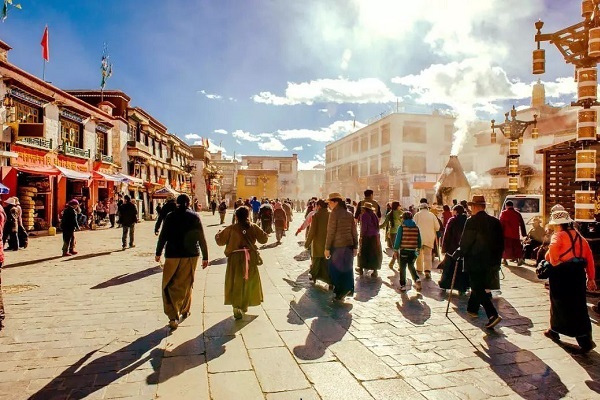
Lhasa and Surrounding Areas
Peasants living in the surrounding area of Lhasa usually wear white round-necked pulu robes with red, yellow, and blue cross-patterned collars, cuffs, and sides of the robe. The robe is slightly longer than a person's height. When wearing it, use a rope to fold the robe and tie it around the waist so that the robe is just over the knee, and a pocket is formed at the waist for daily necessities. Tibetan clothing for Lhasa citizens is somewhat different from that of farmers, especially women's clothing. In summer, women in Lhasa wear sleeveless long skirts. The choice of colors and fabrics is completely different from that of herders and farmers. Lhasa citizens like to use fabrics such as silk and serge with better textures for clothing, and they prefer to choose simple and elegant colors, which are the opposite of the bright red and green colors that farmers and herdsmen love.
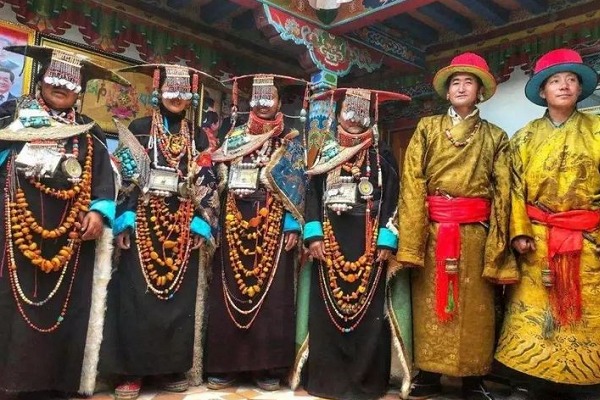
Ngari
Ngari Prefecture is the most remote region in Tibet. Lambskin gowns are popular in the Purang area, which is delicately made and elegantly decorated. The fabric of the lambskin grow is mainly woolen cloth. The collar, sleeves and bottom of the placket are inlaid with otter skin. The overcoat is in silks and satins, inlaid with many jewels, which are unique in the entire Tibetan area. Among them, the most representative, exquisite and unique Purang clothing is the “peacock" costume for women. It is closely linked with the famous Kongque River in Ngari. The head source of the Kongque River is like a peacock, which is the symbol of beauty and auspiciousness.
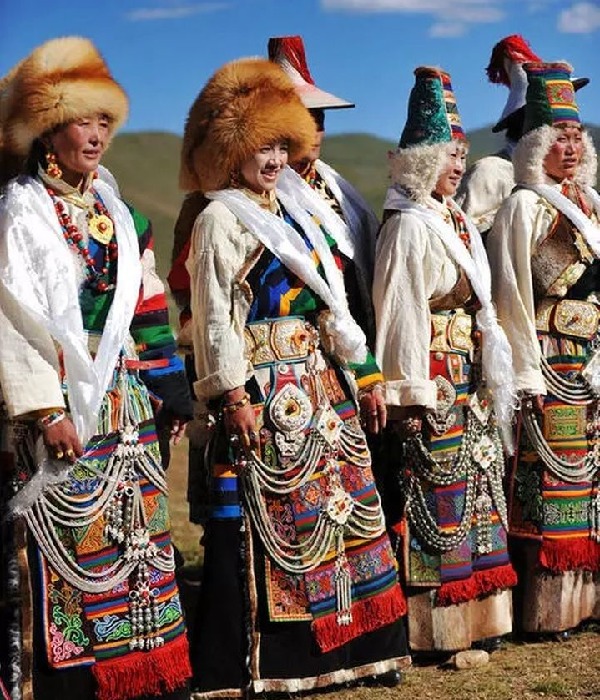
Northern Tibet
Nagqu in Northern Tibet is a purely pastoral area. Due to the high altitude and low temperature, there's no summer and people wrap in a Tibetan robe all year long. The sheepskin produced here is the main raw material for making Tibetan robes. This kind of sheepskin robes are large and heavy but can be used as clothing during the day and as a quilt at night. Therefore people can withstand the harsh alpine climate on the plateau of northern Tibet. Sheepskin robes are mostly unhaired surfaces, and some are sewn with black velveteen trim on the cuffs, placket, hem, etc. The herdsmen wear red felt hats, as well as exquisitely made snuff bottles, waist knives, and muskets around their waists. These objects are not only the utensils on which they live but also the embodiment of their decoration and wealth.
The costumes of women in northern Tibet have a strong sense of contrast, and the striped and colorful Tibetan robes are like walking rainbows. Their sheepskin robes are sewn with red, blue, and green velvet strips as decoration, and their waists are usually covered with things such as sewing boxes and shepherd whips. The whole set of costumes is colorful and full of ethnic characteristics.
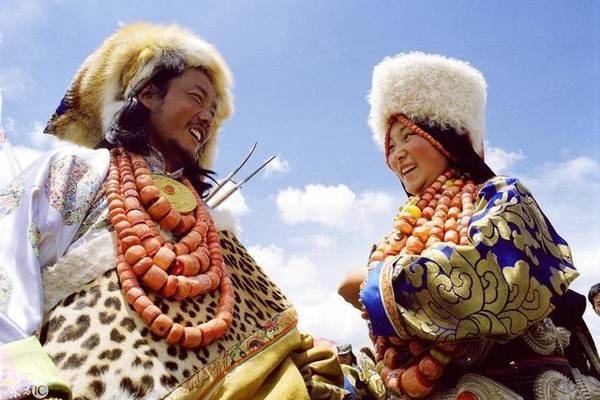
Qamdo
The domineering people of Qamdo have a certain position in the hearts of Tibetans, and they are also called Khampas. The clothing for Kham Tibetan is generally baggy, like those in the pastoral areas of northern Tibet. Khampa costumes are grand and rough. They wear gold, silver, ivory, jade and other jewelry, and hang knives, fire sickles, wallets, and other living utensils around their waists, which are convenient and practical, and have a decorative effect. It also shows the unruly national character of the Khampas. There is a big temperature difference between day and night in Kham, and one sleeve can be taken off when it is warm during the day. In daily life, the colors of Khampa women's clothing are not as bright as those in northern Tibet but slightly simpler. However, their headwears are more unique, with gold inlaid with red coral and worn on the head in three strands.
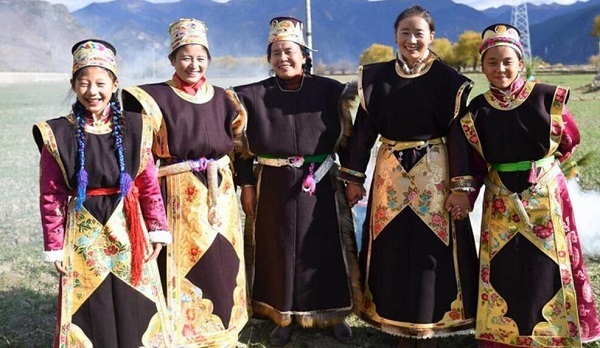
Nyingchi
Nyingchi is a prefecture with low altitude and rich forest vegetation in southeast Tibet. People here used to hunt for a living. The natural environment and mode of production have also affected the local clothing culture. The Tibetans in this area are called Kongbo Tibetans, and their costumes are made of pulu and satins, which look like a lengthened waistcoat.
Shigatse
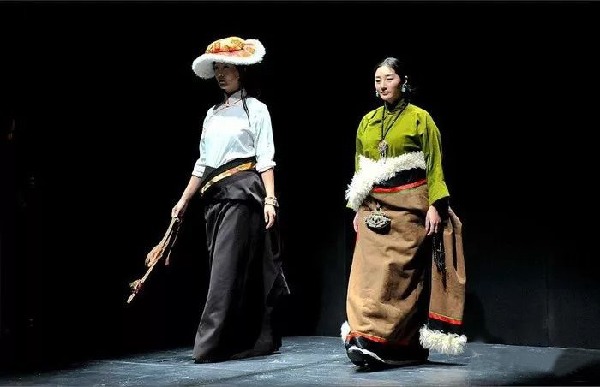
It's cold in Shigatse prefecture all year round. The locals usually wear leather robes with wide trims on the cuffs and hems. Yadong County is located in a forest area, wet and rainy. Local women like to wear a red woolen shawl over their Tibetan robes and fasten it with a silver clasp on the front, which is generous and beautiful. The waist buckle "Gedi" is also one of the important ornaments of Shigatse women, with various shapes and rich pattern types. The waist buckles worn by women in Tingri are huge, some are about 20 centimeters in length and width, covering the entire waist.
Features of Traditional Tibetan Clothing and Accessories
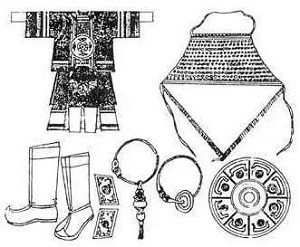
Features of Traditional Tibetan Dress
The basic characteristics of traditional Tibetan dress are that the Tibetan robe must also be worn with an inner garment, right front part, a large waist, a pair of wide and long sleeves. Collars, garment front, cuffs, hem, etc. are mostly trimmed with fine fur, Tibet wool, or colored cloth. In order to adapt to the mobility of livestock production, it gradually formed the feature of the big front, belt tied on the waist, and outstanding space (similar to a bag) in front of the chest. When going out, this space is convenient to store butter, Zanba, tea, rice bowl, and even babies. In Tibetan areas, there are sometimes four seasons of climate change within a day. During the daytime, taking off one sleeve or two sleeves and tying them around the waist is easy to work. When sleeping at night, unwrap the belt, take off two sleeves, make it a warm sleeping bag. So Tibetan clothing is really multi-purpose.
Features of Tibetan Clothing Accessories
The basic features of Tibetan clothing determine a series of clothing accessories. Tibetan costumes are characterized by the extensive use of gold, silver, jade, jewelry and other ornaments. Since gold and silver are symbols of nobility, luxury, dignity and purity, it has become one of the aesthetic characteristics of many ethnic costumes.
Headdress plays an important role in Tibetan clothing. There are many kinds of headdresses for women, among which the famous ones are Bazhu (Spa phrug) and Baguo(Spa sgor). The texture of the headdress can be copper, silver, gold engravings, jade, coral, pearls or other treasures. Tibetan women like embellishing their hair braids with gold, silver, beads and jade, and wearing "Gawu" (an amulet Buddha box), earrings, necklaces, bracelets, rings, etc.
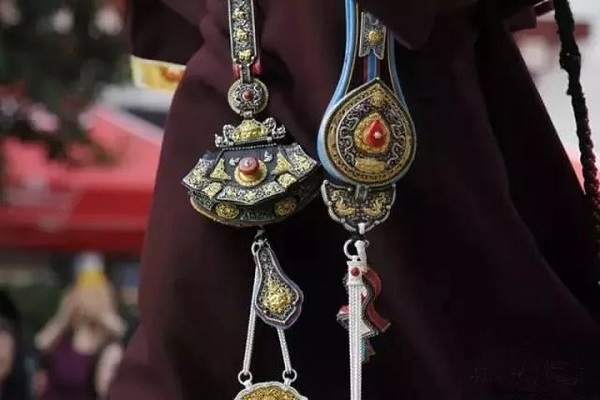
Accessories in the waist are the most distinctive. Men often wear Tibetan Knife as well as earrings and bracelets. The exquisite ones also inlaid their accessories with gold and silver jewelry.
In addition, Tibetan men and women like to wear Xamo Gyaise - a golden thread hat, and herdsmen like to wear fox fur hats.
Tibetans are accustomed to wearing long boots, the soles of the boots are mostly cowhide, and various colorful patterns are embroidered on the boots, which are beautiful and generous.
Related Articles
- Tibetan Handicrafts
- Mani Stone - Mysterious Tibetan Folk Art
- Tibetan Art
- Tibetan Mask - Show Tibetan Culture with Rich Expressions
- Tibet Customs and Traditions
- Tibetan Architecture
- Tibetan Stupa and Chorten
- Songtsen Gampo
- Prayer Wheel - Every Turn is Equivalent to Chanting Once
- Zhangzhung: The Ancient Tibetan Kingdom and Culture


No comments:
Post a Comment